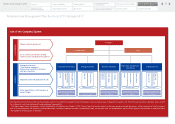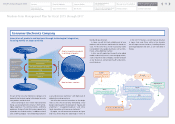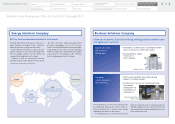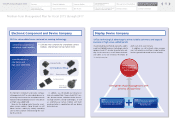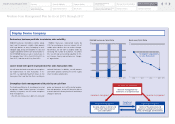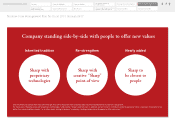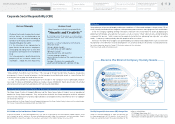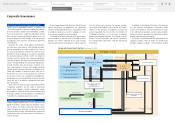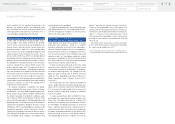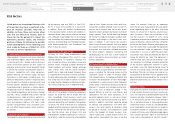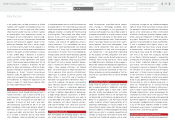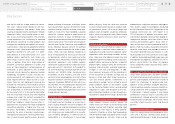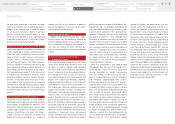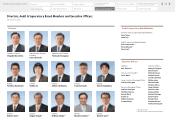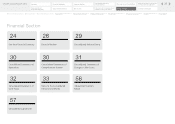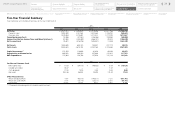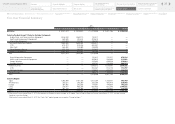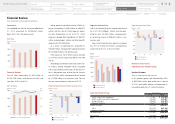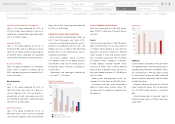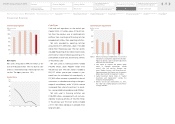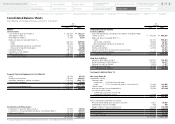Sharp 2015 Annual Report Download - page 21
Download and view the complete annual report
Please find page 21 of the 2015 Sharp annual report below. You can navigate through the pages in the report by either clicking on the pages listed below, or by using the keyword search tool below to find specific information within the annual report.
in the supply chain, or legal restrictions, or limited
suppliers with capability of providing certain ma-
terial provisions. Due to these and other factors,
Sharp may be unable to access sufficient supplies
of materials/parts from procurement sources, or
the quality of such materials/parts may be inade-
quate. In such an event, Sharp may be forced to do
business with alternative suppliers subject to con-
ditions less favorable than with its current suppli-
ers, or Sharp may be unable to find a supplier in a
timely manner. Any of these factors could lead to a
decline in the quality of Sharp’s products, increases
in costs, and/or delays in deliveries to customers,
which may affect Sharp’s business results and fi-
nancial position. Under agreements with certain
clients, Sharp receives advanced payments for the
trading value of its products. At present, the obli-
gation to repay such advances is offset by Sharp’s
accounts receivable in connection with said clients.
Depending on Sharp’s financial circumstances,
however, under the agreements with said clients,
Sharp may be requested to repay a major portion
of the advances. If a request for repayment of ad-
vances is made, this could have a negative effect
on Sharp’s operating cash flows.
(7) Other Factors Affected by Financial Position
Sharp procures funds through borrowings from fi-
nancial institutions, such as banks and life insur-
ance companies, and through bond issues. As of
March 31, 2015, the balance of such debt was
equivalent to 48.6% of total assets, and short-
term borrowings accounted for 88.1% of such
debt. Accordingly, Sharp might become subject to
restrictions on how it uses its cash flows in order
to repay such debt, and also faces the possibility
of an increase in expenses due to rising interest
rates. Moreover, Sharp has possibility of increases
in fund procurement costs as well as limitations on
fund procurement. This may be because necessary
funds cannot be obtained at the required time with
adequate conditions, including for the refinancing
of existing debt. These factors may affect Sharp’s
business results and financial position. Sharp has
borrowing agreements with multiple financial in-
stitutions, and some of the agreements entail fi-
nancial covenants. If its consolidated net assets
fall below the levels specified under such financial
covenants, or if Sharp fails to undertake faithful
consultations in the event that its consolidated op-
erating income and net income fall below specified
levels, Sharp may forfeit the benefit of time at the
lender’s request. Moreover, Sharp may also forfeit
the benefit of time on bonds and other borrow-
ings if it violates the relevant financial covenants.
Sharp’s major lending institutions are Mizuho
Bank, Ltd. and The Bank of Tokyo-Mitsubishi UFJ,
Ltd. As necessary, Sharp consults with both banks
about ways to improve its financial position and
other matters. In June 2013, one of member of
each bank was appointed as a director of Sharp. In
June 2015, moreover, two persons nominated by
Japan Industrial Solutions Fund I—which will pur-
chase Class B Shares in a subscription agreement
with Sharp—have been elected as outside directors
of Sharp. In addition, dependence on borrowings,
a credit ratings reduction caused by it, or deteri-
oration of Sharp’s financial position may work to
its disadvantage with respect to competition with
other companies with robust financial positions,
and contract-related issues could also arise be-
tween Sharp and its lenders or business partners.
(8) Technological Innovation
New technologies are emerging rapidly in the mar-
kets where Sharp operates. Resultant changes in
social infrastructure, intensified market compe-
tition, changes in technology standards, obso-
lescence of technologies, or the appearance of
substitute technologies may make Sharp unable to
introduce new products in a timely manner, or lead
to an increase in inventories, or the inability to re-
cover product development costs. These and other
factors may impact Sharp’s business results and fi-
nancial position. Apart from technologies, Sharp
faces intense competition from price and mar-
keting perspectives as well, and winning against
such competition is not guaranteed. Depending
on the outcome of fierce competition with other
companies, Sharp may be forced to downsize or
withdraw from existing businesses, which could
incur additional costs. Moreover, Sharp engages in
R&D under collaborative development agreements
with other companies, and it is possible that such
relationships cannot be maintained, or that satis-
factory outcomes cannot be produced, or that ter-
mination of such relationships cannot be handled
smoothly.
(9) Intellectual Property Rights
Sharp strives to protect its proprietary technolo-
gies by acquiring patents, trademarks, and other
intellectual property rights in Japan and in other
countries, and by concluding contracts with other
companies. However, there is a risk that rights may
not be granted, or a third party may demand invali-
dation of an application, such that Sharp may be
unable to obtain sufficient legal protection of its
proprietary technologies, or may be unable to re-
ceive sufficient royalty income from the granting of
licenses. In addition, intellectual property that Sharp
holds may not result in a superior competitive ad-
vantage, or Sharp may not be able to make effec-
tive use of such intellectual property, such as when
a third party infringes on the intellectual property
rights of Sharp. There may also be instances where
the period of a license received from a third party
expires, or for some reason or other, is terminated,
or where a third party launches litigation against
Sharp, claiming infringement of intellectual prop-
erty rights. Resolution of such cases may place a
significant financial burden on Sharp. Furthermore,
if such a third-party claim against Sharp is rec-
ognized, Sharp may have to pay a large amount
of compensation, and may incur further damage
by having to cease using the technology in ques-
tion. Also, in the event that a company licensed
to use Sharp’s intellectual property is acquired by
a third party, the third party, previously unlicensed
to use Sharp’s intellectual property, may acquire
such license, with the result that Sharp’s intellec-
tual property may lose its superiority. Alternatively,
the formation of an alliance with said third party
could result in Sharp’s business becoming subject
to new restrictions to which it had not previously
been subject, the resolution of which may require
Sharp to pay additional compensation. Moreover,
the formation of such an alliance could result in
claims for infringement of an existing licensing
agreement with another third party, placing pres-
sure on Sharp to cancel said alliance. Furthermore,
although compensation is given to employees for
innovations that they make in the course of their
work pursuant to a patent reward system governed
by internal regulations, an employee may consider
such payment inadequate and initiate legal action.
If any of the above problems related to intellec-
tual property were to occur, it could impact Sharp’s
business results and financial position.
(10) Long-Term Investments and Agreements
Sharp actively invests in manufacturing equipment
Risk Factors
19
Risk Factors
Segment Outline
Medium-Term Management Plan
for Fiscal 2015 through 2017
Financial Section
Investor Information
Directors, Audit & Supervisory Board
Members and Executive Officers
Corporate Governance
Contents
Corporate Social
Responsibility (CSR)
Message to our Shareholders
Fiscal 2014 Review by
Product Group
Financial Highlights
SHARP Annual Report 2015


